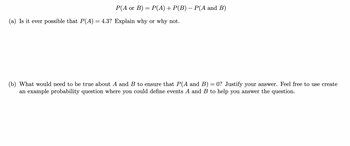
A First Course in Probability (10th Edition)
10th Edition
ISBN: 9780134753119
Author: Sheldon Ross
Publisher: PEARSON
expand_more
expand_more
format_list_bulleted
Question

Transcribed Image Text:P(A or B) = P(A) + P(B) – P(A and B)
(a) Is it ever possible that P(A):
=
4.3? Explain why or why not.
(b) What would need to be true about A and B to ensure that P(A and B) = 0? Justify your answer. Feel free to use create
an example probability question where you could define events A and B to help you answer the question.
Expert Solution
This question has been solved!
Explore an expertly crafted, step-by-step solution for a thorough understanding of key concepts.
Step by stepSolved in 2 steps

Knowledge Booster
Similar questions
- Events A and B are independent. Find the missing probability. P(A) = (9/20) %3D 20 P(B) = ? 27 P(A and B) = (27/80) 80 O 7 10 O 53 80 O 11 25arrow_forwardEvents A and B are independent. Find the missing probability. 9. P(B) = ? 50 11 ; P(A®) = P(A N B) = 20arrow_forwardEvents A and B are independent. Find the missing probability. P(A) = (1/2), P(A and B) = (5/6), P(B) = 3/5 1/2 1/4 4/5arrow_forward
- A and B are events. Use the following data to answer the following questions. P(A)=0.60 P(B)=0.40 P(B/A)=0.40 P(AC) P(A AND B) P(A OR B)arrow_forwardp(a) =0.36 p(B)=0.50 a( a and b) = 0.2365 find out the probability of p( a or B )arrow_forwardAll events are mutually exclusive. Find the probability in question.arrow_forward
- Events A and B are independent. Find the missing probability. P(A and B) 5 P(A) = ? 5 11 P(A and B) = 20 143 P(A) = ? 400 P(B) = P(B) = 13 P(B) 20 2 9 P(B) = 20 3 P(A and B) = ? 4 P(A) = Р(A and B) 3D ? P(A) =-arrow_forwardQ13: If A and B are two events such that P(A) = p₁, P(B) = P2, P(ANB) = P3, then the probability that A occurs but B does not occur is: (a) P1 - P3 (b) P1 P2 (c) P1 - P2P3 (d) P1 — P1P2arrow_forwardEvents A and B are independent events with P(A) = 0.25 and P(B) = 0.35. The probability of the complement of Event B equalsarrow_forward
- Write as a decimalarrow_forwardWhen sent a questionnaire, 50% of the recipients respond immediately. Of those who do not respond immediately, 60% respond when sent a follow-up letter. If the questionnaire is sent to 4 persons and a follow-up letter is sent to any of the 4 who do not respond immediately, what is the probability that at least 3 never respond? A D E (0.2) 4 + 4.(0.2) ³. (0.8) (0.2)4 + 4.(0.2).(0.8)³ (0.4) 4 + 4C (0.4) ³. (0.6) (0.9)4 + 4.(0.9) ³. (0.1) 4.(0.2) ³ (0.8)arrow_forwardLet A and B be two events such that the probability of B is 0.5 and the probability of both is 0.2. Find the probability of A given that B occurs.arrow_forward
arrow_back_ios
arrow_forward_ios
Recommended textbooks for you
 A First Course in Probability (10th Edition)ProbabilityISBN:9780134753119Author:Sheldon RossPublisher:PEARSON
A First Course in Probability (10th Edition)ProbabilityISBN:9780134753119Author:Sheldon RossPublisher:PEARSON

A First Course in Probability (10th Edition)
Probability
ISBN:9780134753119
Author:Sheldon Ross
Publisher:PEARSON
